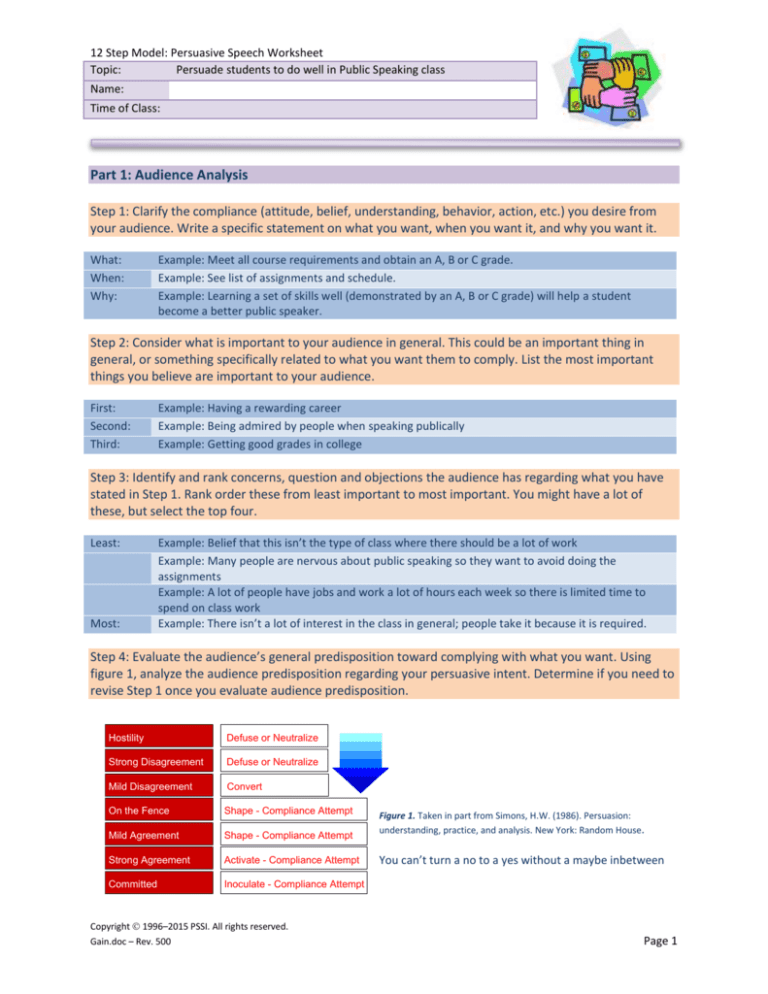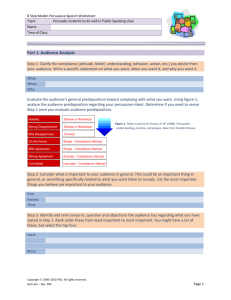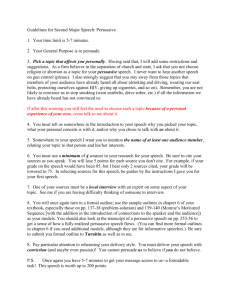
12 Step Model: Persuasive Speech Worksheet
Topic:
Persuade students to do well in Public Speaking class
Name:
Time of Class:
Part 1: Audience Analysis
Step 1: Clarify the compliance (attitude, belief, understanding, behavior, action, etc.) you desire from
your audience. Write a specific statement on what you want, when you want it, and why you want it.
What:
When:
Why:
Example: Meet all course requirements and obtain an A, B or C grade.
Example: See list of assignments and schedule.
Example: Learning a set of skills well (demonstrated by an A, B or C grade) will help a student
become a better public speaker.
Step 2: Consider what is important to your audience in general. This could be an important thing in
general, or something specifically related to what you want them to comply. List the most important
things you believe are important to your audience.
First:
Second:
Third:
Example: Having a rewarding career
Example: Being admired by people when speaking publically
Example: Getting good grades in college
Step 3: Identify and rank concerns, question and objections the audience has regarding what you have
stated in Step 1. Rank order these from least important to most important. You might have a lot of
these, but select the top four.
Least:
Most:
Example: Belief that this isn’t the type of class where there should be a lot of work
Example: Many people are nervous about public speaking so they want to avoid doing the
assignments
Example: A lot of people have jobs and work a lot of hours each week so there is limited time to
spend on class work
Example: There isn’t a lot of interest in the class in general; people take it because it is required.
Step 4: Evaluate the audience’s general predisposition toward complying with what you want. Using
figure 1, analyze the audience predisposition regarding your persuasive intent. Determine if you need to
revise Step 1 once you evaluate audience predisposition.
Hostility
Defuse or Neutralize
Strong Disagreement
Defuse or Neutralize
Mild Disagreement
Convert
On the Fence
Shape - Compliance Attempt
Mild Agreement
Shape - Compliance Attempt
Figure 1. Taken in part from Simons, H.W. (1986). Persuasion:
understanding, practice, and analysis. New York: Random House.
Strong Agreement
Activate - Compliance Attempt
You can’t turn a no to a yes without a maybe inbetween
Committed
Inoculate - Compliance Attempt
Copyright 1996–2015 PSSI. All rights reserved.
Gain.doc – Rev. 500
Page 1
12 Step Model: Persuasive Speech Worksheet
Topic:
Persuade students to do well in Public Speaking class
Name:
Time of Class:
Part 2: Persuasive Speech Outline
Step 5: State what is important to your audience. Keeping in mind what is important to your audience
(Step 2) clearly tell your audience what they will gain from compliance? Write a short statement on
what the audience will gain. This message will be part of your opening statement during your
presentation.
Example: 90% of you believe that have said that you believe having good speaking skill will help you in your career.
95% state that you admire people who speak well in public. Plus, I know, most everyone wants to do well in
college.
Step 6: State the specific compliance needed. With steps 1-5 in mind, what can you realistically expect
as an outcome of this persuasive attempt? Write a brief outcome statement that includes the value of
compliance.
Note: The idea is to be straightforward with your audience. We are not going to “spring it on them” at the end of
the speech. We clearly state what we want at the beginning of the speech.
Example: I believe that if you complete all of the assignments in this course, get a good grade, and then if you
apply the basic skills each time you speak publically, you will become a very good public speaker.
Step 7: Rank the evidence to be presented. These are going to be the basis of your major points: take
the concerns, questions, and objections from Step 3 and rank them from weakest to strongest.
1.
Concern/question/objection:
Experience:
Data:
Story:
Visual aid:
Humor:
Compliance gaining strategy:
Copyright 1996–2015 PSSI. All rights reserved.
Gain.doc – Rev. 500
Page 2
12 Step Model: Persuasive Speech Worksheet
Topic:
Persuade students to do well in Public Speaking class
Name:
Time of Class:
Transition: Seinfeld Slide.
2. Major point related to
concern/question/objection:
Experience:
Data:
Most people experience some to high levels of anxiety related to
publish speaking. Almost everyone can get over, or manage most
anxiety related to speaking in public.
My experience working with public speakers for 25 years is that there
is a direct correlation between being an expert and being WELLPREPARED, with decreased levels of anxiety and fear. You usually will
always speak on something you know about and if you are well
prepared you will not have a lot of anxiety or fear.
Dr. James McCroskey, the leading authority on CA, believed that
communication apprehension is a broad term that refers to an
individual’s fear or anxiety associated with either real or anticipated
communication with another person or persons. Some people avoid
public speaking classes and speaking opportunities because of anxiety
or fear.
According to Dr. Graham Bodie, a communications professor at LSU,
“Public speaking anxiety is a type of communication apprehension that
produces physiological, cognitive, and behavioral reactions in people
when faced with a real or imagined presentation.”
Story:
Story of student giving a speech and throwing up in the basket and just
right back at it, suggesting that it can be managed, isn’t a big deal and
for some, perhaps takes a little courage.
Visual aid:
Humor:
Compliance gaining strategy:
Copyright 1996–2015 PSSI. All rights reserved.
Gain.doc – Rev. 500
Student throwing up. Hope to demonstrate in a funny way. Seinfeld
quote is a bit of humor.
Friendliness, promise, +expertise, +self-feeling
Page 3
12 Step Model: Persuasive Speech Worksheet
Topic:
Persuade students to do well in Public Speaking class
Name:
Time of Class:
3.
Concern/question/objection:
Experience:
Data:
Story:
Visual aid:
Humor:
Compliance gaining strategy:
4.
Concern/question/objection:
Experience:
Data:
Story:
Visual aid:
Humor:
Compliance gaining strategy:
Step 8: Select your evidence for each main. That evidence can be experience, or someone else’s
experience, data, or a story.
Step 9: Choose visual aids. Select appropriate visual aids for each major point.
Compliance Gaining Strategies
strategy
pro-social
promise
+expertise
friendliness
pre-giving
+ morality
+ self-feeling
+ esteem by others
+ social role
+ altruism
strategy
anti-social
threat
- expertise
- consequences
- morality
- self-feeling
- esteem by others
- social role
- debt
Copyright 1996–2015 PSSI. All rights reserved.
Gain.doc – Rev. 500
general illustration
“if you do this, I guarantee this...”
“from my experience you will see these benefits....”
smiling. being friendly, open, likeable.
“we would like to provide this free copy….”
“this is the right thing to do.”
“this is something you will really enjoy doing.”
“doing this will make you look good to….”
“good fathers....” “high performing students…”
“i really need your help, can you do this for me?”
general illustration
“your…is on the line here.”
“I know from experience that if you don’t do this you will face…”
“until you begin taking better care of yourself…”
“it is unethical for you not to do this.”
“not doing this will make you unhappy.”
“…is not going to think well of you if you can’t do this.”
“it would be irresponsible for you as a manager not to do this.”
“you owe me on this.”
Page 4
12 Step Model: Persuasive Speech Worksheet
Topic:
Persuade students to do well in Public Speaking class
Name:
Time of Class:
Figure 2. Marwell and Schmitt (1967) originated this line of research. The above is adapted from Pfau, M., Parrott, R., Birk, T., & Coker, R.
(1987). Relational communication, satisfaction, compliance-gaining strategies, and compliance in communication between physicians and
patients. Communication Monographs, 54, 307-324.
Step 10: Identify implied or verbal compliance gaining strategies being used for each major point.
General rule is to keep it positive and use variety.
Step 11: Optional, but highly recommended, identify the humor you are you going to use for each major
point.
Step 12: agree on next step. What next steps are required by the audience to demonstrate compliance?
Story
Type of story: Change or Learning Story
Write your story:
It was a typical bright and beautiful day in the desert one day at the University of Arizona and my students were
giving speeches. It was a large classroom in the oldest historic building on campus, maybe three or four times the
size of this room, hardwood floors, 15ft ceilings and windows 10 feet tall. A male student about 19 years old was
speaking. Everything was typical, he looked fine, and then all of sudden and 3 minutes into the speech, he quickly
walked over to the wastebasket, threw up and then went back to his speech without saying a thing. We all just
stared at him. The lesson I learned was, nervousness is no big deal, the audience get’s it, and anyone can give a
speech even if they are nervous because it doesn’t get worse that that.
Evidence
Use at least two supporting pieces of evidence. This must be credible and a primary source.
1.
Evidence:
Credibility statement?
How is this a primary source?
Citation (not an internet address):
Copyright 1996–2015 PSSI. All rights reserved.
Gain.doc – Rev. 500
Dr. James McCroskey, the leading authority on CA, believed that
communication apprehension is a broad term that refers to an
individual’s fear or anxiety associated with either real or anticipated
communication with another person or persons. Some people avoid
public speaking classes and speaking opportunities because of anxiety
or fear.
Associate profession of communication at a respectable university
Directly from journal article by Bodie.
Graham D. Bodie, “A Racing Heart, Rattling Knees, and Ruminative
Thoughts: Defining, Explaining, and Treating Public Speaking
Page 5
12 Step Model: Persuasive Speech Worksheet
Topic:
Persuade students to do well in Public Speaking class
Name:
Time of Class:
Anxiety,” Communication Education 59, no. 1 (2010): 71
2.
Evidence:
Dr. James McCroskey, the leading authority on CA, believed that
communication apprehension is a broad term that refers to an
individual’s fear or anxiety associated with either real or anticipated
communication with another person or persons. Some people avoid
public speaking classes and speaking opportunities because of anxiety
or fear.
Credibility statement?
Why is this a primary source?
Citation (not an internet address):
One of the top five communication researchers
Directly from journal article by McCroskey.
McCroskey, J. C. (2001). An introduction to rhetorical communication.
Boston, MA: Allyn & Bacon, p. 40.
Interview and Survey
Use the information from one interview and/or survey.
Provide this information of the interview:
If you are doing a survey, include the completed surveys.
Checklist
I have completed the 12 Step Model: Persuasive Speech Worksheet above
I have used complete sentences in the Worksheet
I have at least four and no more than 6 main points
I have at least one visual aid for each main point (PowerPoint slide, chart, picture, etc.)
I have at least two primary source credible references used as supporting evidence
I have at least one story to illustrate one of my main points, or to gain attention or to close the speech
If I have a PowerPoint/keynote I emailed to Ray the day before the speech
This worksheet is stapled, and I have a copy to hand to Ray before I give my speech
I have at least one survey and/or one interview
If I am using a survey, I have included the results with this outline. (Completed surveys of at least 10
people.)
If I am using an interview, I have included the details of that interview. (Name, date, interview questions,
answers, etc.)
Copyright 1996–2015 PSSI. All rights reserved.
Gain.doc – Rev. 500
Page 6




